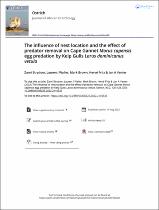| dc.description.abstract | The breeding range of the Cape Gannet Morus capensis currently extends to six of the ten islands formerly utilised
by this species. The Cape Gannet is classified as an endangered species with a rapidly declining population. Since
the mid-1950s, the global population has declined by 51% due to multiple causes, including egg predation by the
Kelp Gull Larus dominicanus vetula. To assess the effect of this predation, we monitored 100 nests over an 11-week
period in 2018 at the Lambert’s Bay colony in South Africa. To assess the effect of selective predator removal on
the likelihood of predation, data were collected from 2006 and 2018. Our objective was to assess whether nest
location and predator removal affected the likelihood of egg predation. The peripheral nests saw a higher level of
egg loss (average 1.5 eggs per week) compared with the central nests (average 1 egg per week). Predator control
of Kelp Gulls was implemented in 2015, 2017 and 2018. Between years, selective culling decreased the number
of Cape Gannet eggs predated. However, within years, except for 2015, the predation rate on Cape Gannet eggs
increased post-culling during the same year of implementation. In all three of the implementation years, predation
started again (within 48 hours) after the culling commenced. Predation by this indigenous gull species is natural;
however, certain human activities might have supported larger populations of Kelp Gulls leading to elevated
predation intensity. | en_US |

